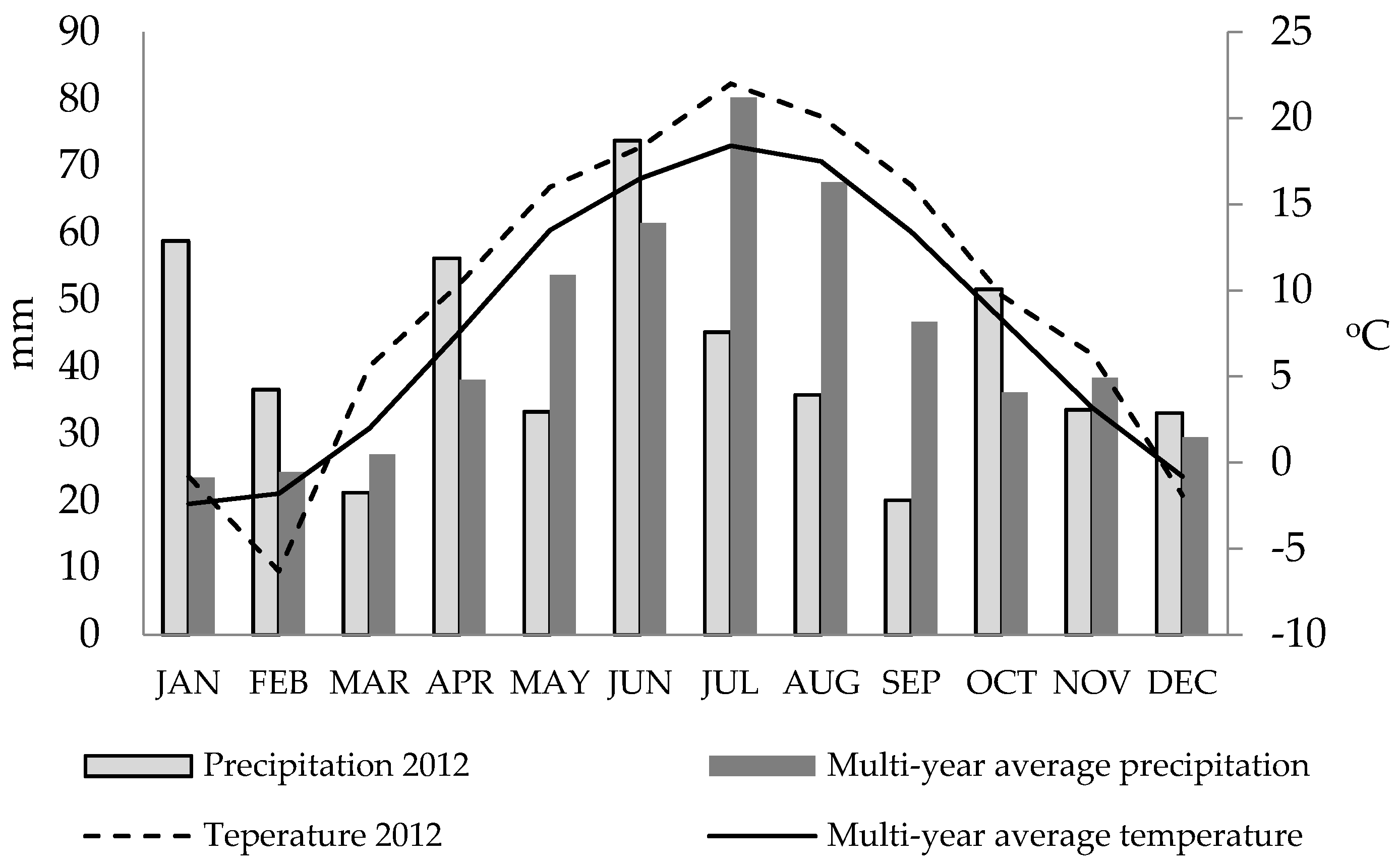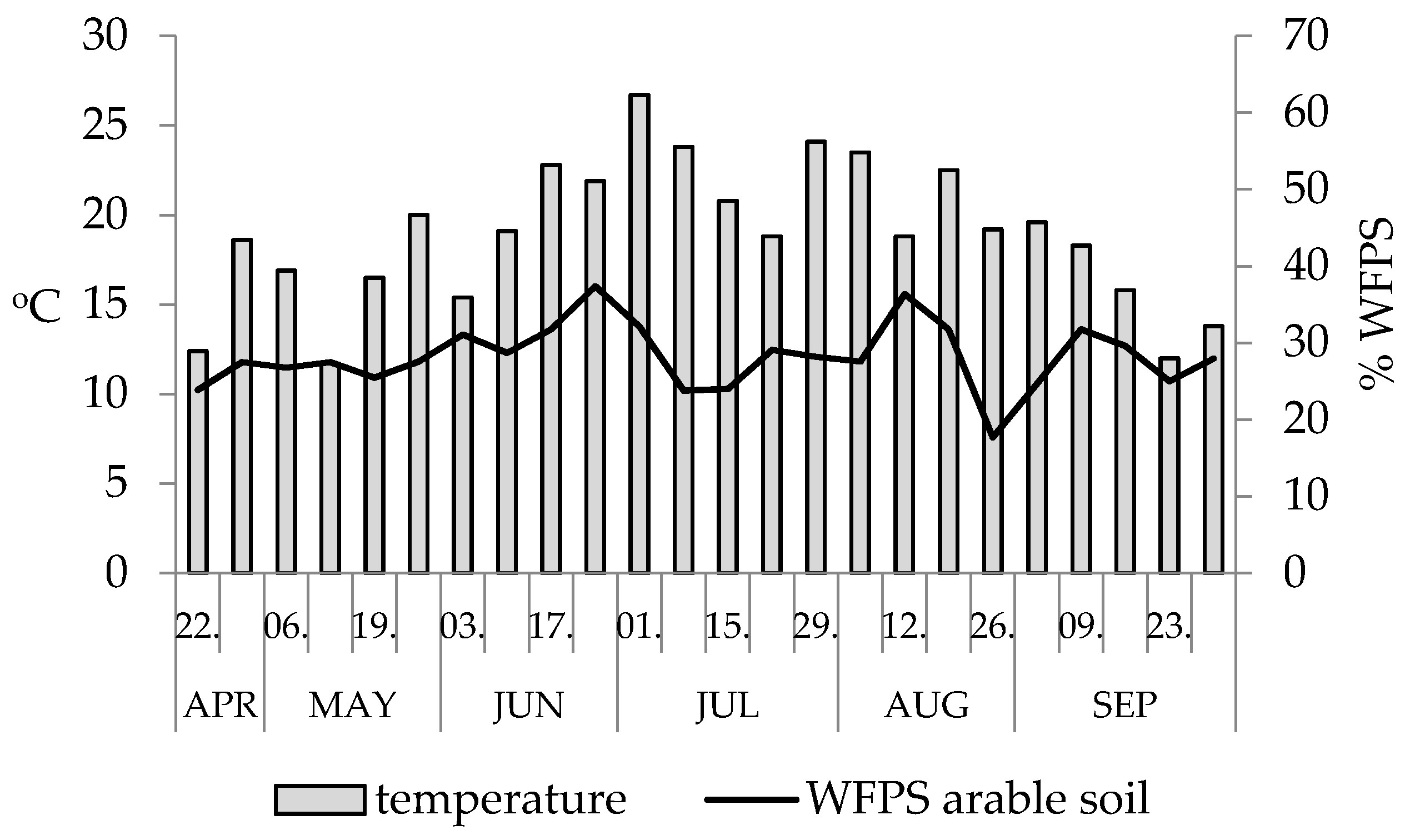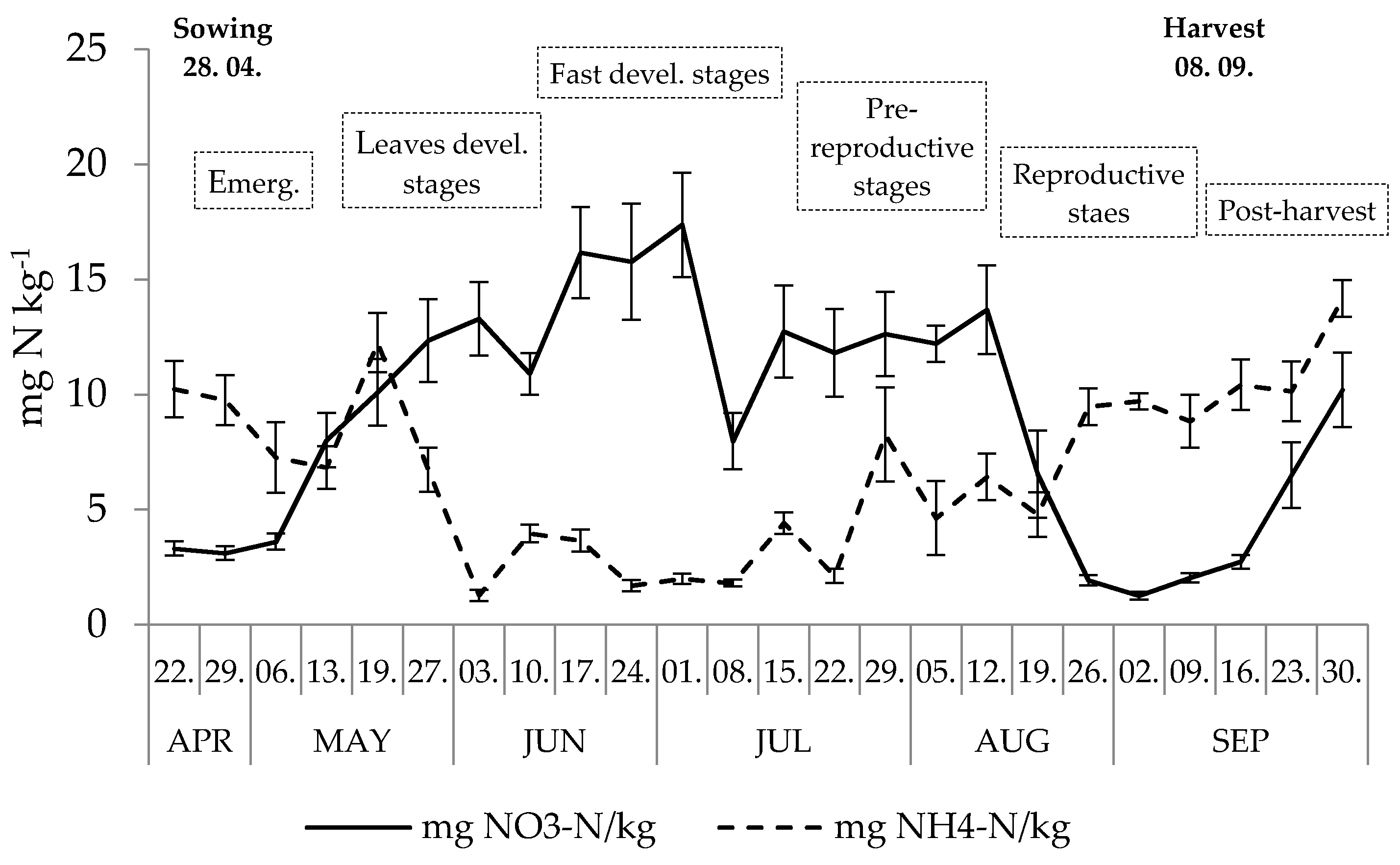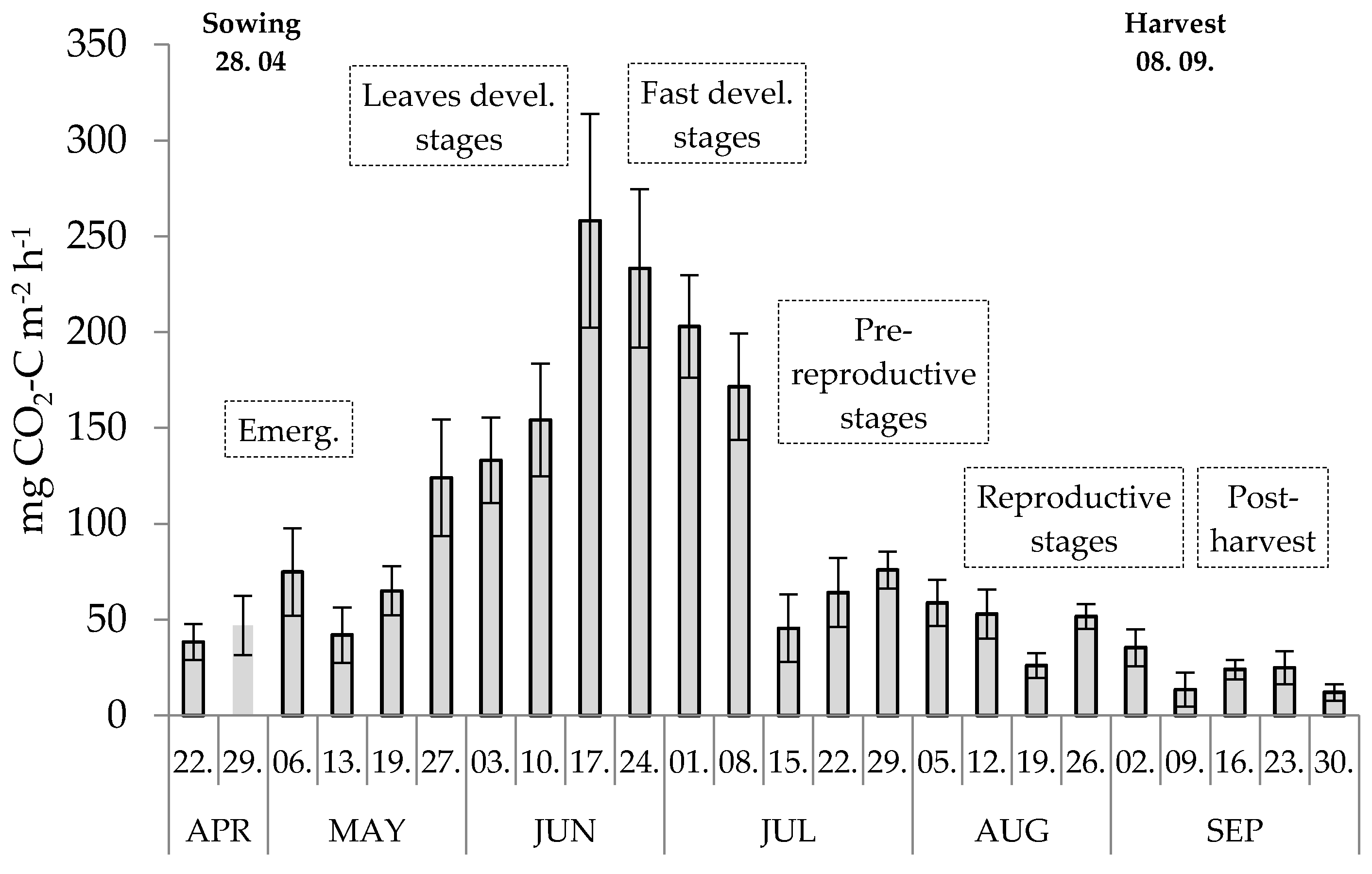CO2 Emissions from Soil Under Fodder Maize Cultivation
Abstract
1. Introduction
2. Materials and Methods
2.1. Study Area
2.2. Weather Conditions
2.3. Measurement Descriptions
2.4. Data Analysis
3. Results
3.1. Mineral Nitrogen Soil Content
3.2. CO2-C Soil Emissions
4. Discussion
4.1. Soil Organic Carbon Content
4.2. Relationship Between CO2-C Soil Emissions and Temperature and Soil Moisture
4.3. CO2-C Soil Emissions and Mineral Nitrogen Soil Content
5. Conclusions
Author Contributions
Funding
Conflicts of Interest
References
- Statista. Worldwide Production of Grain in 2018. Available online: https://www.statista.com/statistics/263977/world-grain-production-by-type/ (accessed on 4 June 2020).
- Agriculture, Forestry and Fisheries; Eurostat. Statistics Explained. Available online: https://ec.europa.eu/eurostat/statistics-explained/ (accessed on 4 June 2020).
- Rozkrut, D. Statistical Yearbook of Agriculture; Statistics Poland: Warsaw, Poland, 2020; pp. 1–439. (In Polish) [Google Scholar]
- Ranum, P.; Pena-Rosas, J.; Garcia-Casal, M.N. Global maize production, utilization, and consumption. Ann. N.Y. Acad. Sci. 2014, 1312, 105–112. [Google Scholar] [CrossRef] [PubMed]
- Król, A.; Księżak, J.; Kubińska, E.; Rozakis, S. Evaluation of sustainability of Maze cultivation in Poland. A prospect theory—PROMETHEE approach. Sustainability 2018, 1011, 426363. [Google Scholar]
- Oertel, C.; Matschullat, J.; Zurba, K.; Zimmermann, F.; Erasmi, S. Greenhouse gas emissions from soils—A review. Chem. Erde 2016, 76, 327–352. [Google Scholar] [CrossRef]
- Guo, L.B.; Gifford, R.M. Soil carbon stocks and land use change: A meta analysis. Glob. Chang. Biol. 2002, 8, 345–360. [Google Scholar] [CrossRef]
- Don, A.; Scholten, T.; Shulze, E.D. Conversion of cropland into grassland: Implication for soil organic carbon stocks in two soils with different texture. J. Plant Nutr. Soil Sci. 2009, 172, 53–62. [Google Scholar] [CrossRef]
- Ding, F.; Hu, Y.L.; Li, L.J.; Li, A.; Shi, S.; Lian, P.Y.; Zeng, D.H. Changes in soil organic carbon and total nitrogen stocks after conversion of meadow to cropland in Northeast China. Plant Soil 2013, 373, 1–2. [Google Scholar] [CrossRef]
- Tang, S.; Guo, J.; Li, S.; Li, J.; Xie, S.; Zhai, X.; Wang, C.; Zhang, Y.; Wang, K. Synthesis of soil carbon losses in response to conversion of grassland to agriculture land. Soil Tillage Res. 2019, 185, 29–35. [Google Scholar] [CrossRef]
- Paustian, K.; Six, J.; Elliott, E.T.; Hunt, H.W. Management options for reducing CO2 emissions from agricultural soils. Biogeochemistry 2000, 48, 147–163. [Google Scholar] [CrossRef]
- Sainju, U.; Jabro, J.D.; William, B.S. Soil carbon dioxide emissions and carbon content as affected by irrigation, tillage, cropping system and nitrogen fertilization. J. Environ. Qual. 2008, 37, 98–106. [Google Scholar] [CrossRef] [PubMed]
- Al-Kaisi, M.M.; Yin, X. Tillage and Crop residue effects on soil carbon and carbon dioxide emission in corn-soybean rotation. J. Environ. Qual. 2005, 342, 437–445. [Google Scholar] [CrossRef] [PubMed]
- Rutkowska, B.; Szulc, W.; Sosulski, T.; Skowrońska, M.; Szczepaniak, J. Impact of reduced tillage on emission from soil under maize cultivation. Soil Tillage Res. 2018, 180, 21–28. [Google Scholar] [CrossRef]
- Zhai, L.; Liu, H.; Zhang, J.; Huang, J.; Wang, B. Long-term application of organic manure and mineral fertilizer on N2O and CO2 emissions in a red soil from cultivated maize-wheat rotation in China. Agric. Sci. China 2011, 1011, 1748–1757. [Google Scholar] [CrossRef]
- Norberg, L.; Berglund, Ö.; Berglund, K. Seasonal CO2 emission under different cropping systems on Histosols in Southern Sweden. Geoderma Reg. 2016, 2016. 7, 338–345. [Google Scholar] [CrossRef]
- Dhadli, H.S.; Brar, B.S.; Black, T.A. Influence of crop growth and weather variables on soil CO2 emissions in a maize-wheat cropping system. Agric. Res. J. 2015, 52, 28–34. [Google Scholar] [CrossRef]
- VIEP (Voivodeship Inspectorate of Environmental Protection). Environmental State in the Masovian Voivodeship in 2012; Environment Report; VIEP: Warsaw, Poland, 2013; pp. 1–173. (In Polish) [Google Scholar]
- Burton, D.L.; Zebarth, B.J.; Gillam, K.M.; MacLeod, J.A. Effect of split application of fertilizer nitrogen on N2O emissions from potatoes. Can. J. Soil Sci. 2008, 88, 229–239. [Google Scholar] [CrossRef]
- Pareja-Sánchez, E.; Cantero-Martinez, C.; Alvaro-Fuentes, J.; Plaza-Bonilla, D. Tillage and nitrogen fertilization in irrigated maize: Key practices to reduce soil CO2 and CH4 emission. Soil Tillage Res. 2019, 191, 29–36. [Google Scholar] [CrossRef]
- Aslam, T.; Choudhary, M.A.; Saggar, S. Influence of land-use management on CO2 emissions from a silt loam soil in New Zealand. Agric. Ecosyst. Environ. 2000, 77, 257–262. [Google Scholar] [CrossRef]
- Sosulski, T.; Korc, M. Effects of different mineral and organic fertilization on the content of nitrogen and carbon in soil organic matter fractions. Ecol. Chem. Eng. A 2011, 18, 601–609. [Google Scholar]
- Sosulski, T.; Szara, E.; Stępień, W.; Szymańska, M. Nitrous oxide emissions from the soil under different fertilization systems on a long-term experiment. Plant Soil Environ. 2014, 60, 481–488. [Google Scholar] [CrossRef]
- Abdalla, M.; Hastings, A.; Helmy, M.; Prescher, A.; Osborne, B.; Lanigan, G.; Forristal, D.; Killy, D.; Maratha, P.; Williams, M.; et al. Assessing the combined use of reduced tillage and cover crops for mitigating greenhouse gas emissions from arable ecosystem. Geoderma 2014, 223–225, 9–20. [Google Scholar] [CrossRef]
- Adviento-Borbe, M.A.A.; Haddix, M.L.; Binder, D.L.; Walters, D.T.; Dobermann, A. Soil greenhouse gas fluxes and global warming potential in four high-yielding maize systems. Global Chang. Biol. 2007, 13, 1972–1988. [Google Scholar] [CrossRef]
- Amos, B.; Arkebauer, T.J.; Doran, J.W. Soil surface fluxes of greenhouse gases in an irrigated maize-based agroecosystem. Soil Sci. Soc. Am. J. 2005, 69, 387–395. [Google Scholar] [CrossRef]
- Bogužas, V.; Sinkevičienė, A.; Romaneckas, K.; Steponavičienė, V.; Skinulienė, L.; Butkevičienė, L.M. The impact of tillage intensity and meteorological conditions on soil temperature, moisture content and CO2 efflux in maize and spring barley cultivation. Zemdirbyste 2018, 105, 307–314. [Google Scholar] [CrossRef]
- Song, C.; Zhang, J. Effects of soil moisture, temperature, and nitrogen fertilization on soil respiration and nitrous oxide emission during maize growth period in northeast China. Acta Agric. Scand. B 2009, 59, 97–106. [Google Scholar] [CrossRef]
- Ding, W.; Cai, Y.; Cai, Z.; Yagi, K.; Zheng, X. Soil Respiration under Maize Crops: Effects of Water, Temperature, and Nitrogen Fertilization. Soil Biol. Biochem. 2007, 71, 944–951. [Google Scholar] [CrossRef]
- Ding, W.; Meng, L.; Yin, Y.; Cai, Z.; Zheng, X. CO2 emission in an intensively cultivated loam as affected by long-term application of organic manure and nitrogen fertilizer. Soil Biol. Biochem. 2007, 39, 669–679. [Google Scholar] [CrossRef]
- Francioni, M.; Trozzo, L.; Toderi, M.; Baldoni, N.; Allegrezza, M.; Tesei, G.; Kishimoto-Mo, A.W.; Foresi, L.; Santilocchi, R.; D’Ottavio, P. Soil respiration dynamics in Bromus erectus-dominated grasslands under different management intensities. Agriculture 2020, 10, 9. [Google Scholar] [CrossRef]
- Flessa, H.; Ludwig, B.; Heil, B.; Merbah, W. The origin of soil organic C, dissolved organic C and respiration in a long-term maize experiment in Halle, Germany, determined by 13C natural abundance. J. Plant Nutr. Soil Sci. 2000, 163, 157–163. [Google Scholar] [CrossRef]
- Rochette, P.; Flanagan, L.B.; Gregorich, E.G. Separating soil respiration into plant and soil components using analyses of the natural abundance of carbon-13. Soil Sci. Soc. Am. J. 1999, 63, 1207–1213. [Google Scholar] [CrossRef]
- Dencso, M.; Gelybó, G.; Kása, I.; Pokovai, K.; Potyó, I.; Horel, Á.; Birkás, M.; Takács, T.; Tóth, E. Effect of different management systems on soil CO2 emission and plant growth in a maize field. In Proceedings of the 19th EGU General Assembly, EGU2017, Vienna, Austria, 23–28 April. Geophys. Res. Abstr. 2017, 19, 7727. [Google Scholar]
- Sosulski, T.; Szara, E.; Stępień, W.; Rutkowska, B. The influence of mineral fertilization and legumes cultivation on the N2O soil emissions. Plant Soil Environ. 2015, 12, 529–536. [Google Scholar] [CrossRef]
- Sosulski, T.; Szara, E.; Stępień, W.; Szymańska, M. Impact of liming management on N2O emissions from arable soils in three long-term fertilization experiments in Central Poland. Fresenius Environ. Bull. 2016, 25, 6111–6119. [Google Scholar]





| Statistics | CO2 Soil Emissions (mg C m−2 h−1) | Soil Content | |
|---|---|---|---|
| NO3−-N | NH4+-N | ||
| mg N kg−1 | |||
| Mean ± SD | 84.58 ± 72.37 | 9.01 ± 5.01 | 6.70 ± 3.67 |
| Median | 58.01 | 10.15 | 6.78 |
| Min–max | 3.63–302.31 | 1.26–17.37 | 1.28–14.17 |
| Parameter | Ta | WFPS | NO3−-N | NH4+-N |
|---|---|---|---|---|
| CO2-C | 0.52 | 0.36 | 0.64 | −0.67 |
| Ta | 1.00 | 0.24 | 0.45 | −0.56 |
| WFPS | 0.24 | 1.00 | 0.53 | −0,40 |
| NO3−-N | 0.45 | 0.53 | 1.00 | −0.60 |
| NH4+-N | −0.56 | −0.40 | −0.60 | 1.00 |
| Maize Stages | Date | CO2 Soil Emissions | Min–Max | Variation Coefficient (V%) | Fractals 25, 75 | |
|---|---|---|---|---|---|---|
| Mean ± SD | Median | |||||
| kg C ha−1 day−1 | ||||||
| Emergence | 29.04–13.05 | 12.8 ± 2.66 | 12.5 | 9.22–17.99 | 20.76 | 10.5–15.0 |
| Leaves Development Stages | 14.05–16.06 | 30.8 ± 12.3 | 31.0 | 11.66–58.83 | 39.87 | 21.9–35.7 |
| Fast Development Stages | 17.06–14.07 | 45.8 ± 13.2 | 49.2 | 14.71–61.94 | 28.84 | 41.6–56.4 |
| Pre-reproductive Stages | 15.07–11.08 | 14.9 ± 1.9 | 14.7 | 10.93–18.21 | 12.93 | 13.3–16.6 |
| Reproductive Stages | 12.08–08.09 | 8.8 ± 2.4 | 9.2 | 3.91–12.70 | 26.59 | 7.1–10.7 |
| Post-harvest Period | 09.09–30.09 | 4.9 ± 1.0 | 5.0 | 2.90–5.99 | 20.92 | 4.1–5.9 |
| Maize Stages | Date | Average Emissions ± SD | Min–Max | Variation Coefficient (V%) |
|---|---|---|---|---|
| kg CO2-C ha−1 | ||||
| Emergence | 29.04–13.05 | 282.3 ± 18.3 | 263.33–299.86 | 6.49 |
| Leaves Development Stages | 14.05–16.06 | 1046.6 ± 44.7 | 999.84–1088.91 | 4.27 |
| Fast Development Stages | 17.06–14.07 | 1282.5 ± 145.0 | 1128.66–1416.76 | 11.31 |
| Pre-reproductive Stages | 15.07–11.08 | 416.5 ± 62.2 | 344.94–457.92 | 14.94 |
| Reproductive Stages | 12.08–08.09 | 247.4 ± 21.6 | 222.86–263.69 | 8.75 |
| Post-harvest Period | 09.09–30.09 | 106.8 ± 10.4 | 100.64–118.84 | 9.75 |
| Sowing-harvest | 29.04–09.30 | 3214.9 ± 233.2 | 2957.0–3411.1 | 7.25 |
| Study Period | 22.04–30.09 | 3382.1 ± 206.3 | 3155.83–2559.6 | 6.10 |
© 2020 by the authors. Licensee MDPI, Basel, Switzerland. This article is an open access article distributed under the terms and conditions of the Creative Commons Attribution (CC BY) license (http://creativecommons.org/licenses/by/4.0/).
Share and Cite
Sosulski, T.; Szymańska, M.; Szara, E. CO2 Emissions from Soil Under Fodder Maize Cultivation. Agronomy 2020, 10, 1087. https://doi.org/10.3390/agronomy10081087
Sosulski T, Szymańska M, Szara E. CO2 Emissions from Soil Under Fodder Maize Cultivation. Agronomy. 2020; 10(8):1087. https://doi.org/10.3390/agronomy10081087
Chicago/Turabian StyleSosulski, Tomasz, Magdalena Szymańska, and Ewa Szara. 2020. "CO2 Emissions from Soil Under Fodder Maize Cultivation" Agronomy 10, no. 8: 1087. https://doi.org/10.3390/agronomy10081087
APA StyleSosulski, T., Szymańska, M., & Szara, E. (2020). CO2 Emissions from Soil Under Fodder Maize Cultivation. Agronomy, 10(8), 1087. https://doi.org/10.3390/agronomy10081087





